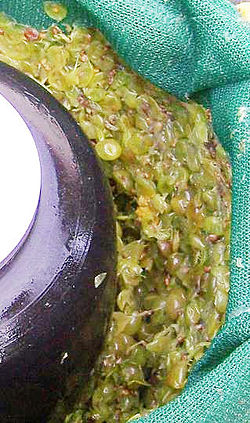Pomace

Pomace(/ˈpʌməs/PUM-əs), ormarc(/ˈmɑːrk/;from Frenchmarc[maʁ]), is the solid remains ofgrapes,olives,or otherfruitafterpressingfor juice or oil. It contains the skins, pulp, seeds, and stems of the fruit.
Grape pomace has traditionally been used to producepomace brandy(such asgrappa,orujo,törkölypálinka,zivania). Today, it is mostly used asfodder,asfertilizer,or for the extraction of bioactive compounds likepolyphenols.[1]
Name[edit]
TheEnglishwordpomacederives fromMedieval Latinpomaceum( "cider") andpomaceus( "pomaceous, appley" ), fromClassical Latinpomum( "fruit,apple").[2]The word was originally used for cider and only later applied to the apple mash before or after pressing, via various cognate terms in northernFrenchdialects,before being used for such byproducts more generally.[2]
History[edit]
Theancient GreeksandRomansused grape pomace to create an inferior class ofwinegiven toslavesand laborers. The grapes were first pressed twice and the resulting pomace was then soaked in water for another day and pressed a third time andfermented.The resulting liquid produced a thin, weak, and thirst-quenching wine with analcohol contentaround 3 or 4%, now known aspiquettein English and French and asgraspiaorvin piccoloinItalian.[3]Piquette was also widely available during theMiddle Ages.As medieval wines were not usually fermented todryness,medieval piquette retained a degree ofresidual sugar.
Pomace from various sources—particularly fish andcastor beans—was also used in theearly modern periodforfertilizer.[2]
Uses[edit]

Apple pomace is often used to producepectinand can be used to makeciderkin,a weakcider,as well aswhite cider,a strong and colourless alcoholic drink.[4]
Distilling[edit]
Grape pomace is used to producepomace brandyandpiquette.Most wine-producing cultures began making some type of pomace brandy after the principles ofdistillationwere understood.
Winemaking[edit]
Pomace inwinemakingdiffers, depending upon whether white wine or red wine is being produced.
In red wine production, pomace is produced after the free run juice (the juice created before pressing by the weight ofgravity) is poured off, leaving behind dark blackish-red pomace consisting of grape skins and stems. The color of red wine is derived from skin contact during themacerationperiod, which sometimes includes partial fermentation. The resulting pomace is more alcoholic andtannicthan pomace produced from white wine production. Pomace from the Italian wineAmaroneis macerated inValpolicellawine to produceRipasso.[citation needed]
In white wine production, grapes are separated from their skins, then pressed to obtain juice. The skin pomace is a pale, greenish-brown color, and containsresidual sugarsandtannins.This pomace is used in brandy production.[5]
Other uses[edit]
Pomace is produced in large quantities in wine production, making its disposal an important environmental consideration. Some wineries use the material as fertilizer, while others are selling it tobiogascompanies forrenewable energy.As envisioned, pomace would be introduced intoanaerobic digestersthat containmicroorganismsthat aid in itsdecompositionand producemethanegas that could be burnt to generate power.[6]
Specificpolyphenolsin red wine pomace may be beneficial fordental hygiene.A study conducted at the Eastman Dental Center found that these polyphenols interfere withStreptococcus mutans,thebacteriumin the mouth that causestooth decay.ProfessorHyun Koo,the lead researcher of the study, hoped as of 2008 to isolate these polyphenols to produce newmouthwashesthat will help protect against cavities.[7]
Grape pomace is also used in the oil and gas industry as alost circulationmaterial in oil-based drilling muds due to the pomace being fibrous and tannin-rich.
A 2004 study conducted byErciyes UniversityinTurkeyfound that pomace can also act as a naturalfood preservativethat interferes withE. coli,SalmonellaandStaphylococcusbacteria. Researchers pulverised the dried pomace from the whiteTurkish winegrapeEmir Karasiand redKalecik Karasigrapes; this was mixed withethyl acetate,methanolor water and exposed to 14 different types of food bacteria. All 14 bacteria were inhibited to some degree by the pomace – depending on the grape variety and the concentration of the extract. The red wine Kalecik Karasi grape was the most effective; the researchers believed this was due to the higher concentration of polyphenols in red wine grape skins.[8]
Oenocyanin,a natural red dye and food-coloring agent, is produced from grape pomace. Tartrates (potassium bitartrate,'cream of tartar') andgrape polyphenolscan also be manufactured from grape pomace.[5]
Apple pomace has long been a traditional feed for various kinds of livestock.[9]The use of grape pomace as livestock feed is encouraged in order to reduce the release of grape processing residues in the environment, which can lead to serious pollution.[10]
Apple pomace was used, in conjunction withwhey,to flavor the first iteration ofFantasoft drink inGermanyduringWorld War II.This was done because wartime embargoes limitedCoca-Colaof Germany's ability to import and manufacture the American beverage.
Apple pomace can also be milled in order to createapple flour,also known as apple pomace flour.
Legal regulations[edit]
Canada[edit]
According to the CanadianFood and Drug Regulations,pomace can be a potable alcoholic distillate or a mixture of potable alcoholic distillates obtained by distilled skin and pulp of sound ripe fruit after removal of the fruit juice, wine or fruit wine. Pomace may contain caramel, fruit, botanical substances, flavoring and flavoring preparations. Pomace may be described on its label as "(name of the fruit) Pomace" or "(name of the fruit) Marc" if all of the skin and pulp of the fruit used to make the pomace originate from the particular fruit.[11]
See also[edit]
References[edit]
- ^Aizpurua-Olaizola, Oier; Ormazabal, Markel; Vallejo, Asier; Olivares, Maitane; Navarro, Patricia; Etxebarria, Nestor; Usobiaga, Aresatz (2015-01-01). "Optimization of Supercritical Fluid Consecutive Extractions of Fatty Acids and Polyphenols from Vitis Vinifera Grape Wastes".Journal of Food Science.80(1): E101–E107.doi:10.1111/1750-3841.12715.ISSN1750-3841.PMID25471637.
- ^abc"pomace,n.",Oxford English Dictionary,Oxford: Oxford University Press, 2023.
- ^Robinson, Jancis (ed.).The Oxford Companion to Wine(Third ed.). p. 532.
- ^"White Cider and street drinkers: Recommendations to reduce harm".Alcohol Concern.April 2011. Archived fromthe originalon 2015-05-12.Retrieved2017-11-12.
- ^abRobinson, Jancis, ed. (2006).The Oxford Companion to Wine(Third ed.). Oxford: Oxford University Press. pp.534–535.ISBN978-0-19-860990-2.
- ^"GrapeVine".Wine Spectator:16. January 31 – February 29, 2008.
- ^"Red-wine waste can check cavities".The Times of India.Asian News International.January 3, 2008. Archived fromthe originalon 2008-01-06.
- ^Gaffney, Jacob (September 23, 2004)."What a Waste! Grape Pomace Kills Food-Spoiling Bacteria".Wine Spectator.
- ^Heuzé, V.; Tran, G.; Hassoun, P.; Lebas, F. (2017)."Apple pomace and culled apples".Feedipedia.INRA, CIRAD, AFZ and FAO.
- ^Heuzé, V.; Tran, G. (2017)."Grape pomace".Feedipedia.INRA, CIRAD, AFZ and FAO.
- ^Branch, Legislative Services. "Consolidated federal laws of Canada, Food and Drug Regulations". laws.justice.gc.ca. Retrieved 2017-07-19.
Further reading[edit]
- Crowe, Alison (August–September 2005)."The Pomace Predicament".WineMaker.Archived fromthe originalon 2010-01-25.
- Hang, Y. D.; Woodams, E. E. (April 1985). "Grape pomace: A novel substrate for microbial production of citric acid".Biotechnology Letters.7(4): 253–254.doi:10.1007/BF01042372.S2CID45128414.
External links[edit]
 Media related toPomaceat Wikimedia Commons
Media related toPomaceat Wikimedia Commons


